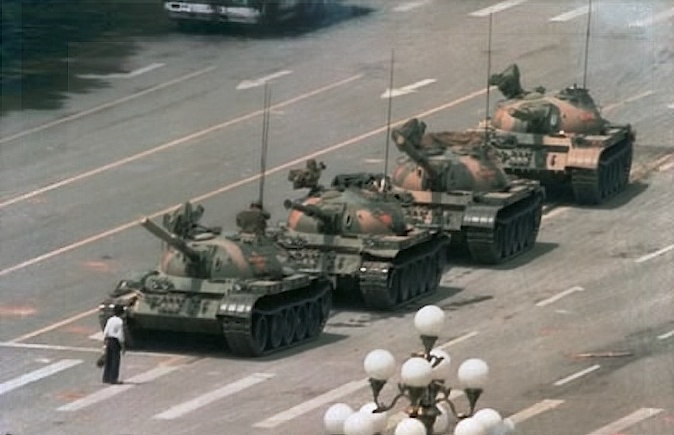这是一张经典的历史照片。今日的北大学生回答记者的采访:“从这张图上看,这是个装备。不太清楚是什么样的场合,也可能是阅兵式或其他的,无法发挥自己的想象……”“我看不出来什么从照片上……”“可以问这是艺术照吗?”……
1989年6月5日清晨,大量坦克驶入长安街,一位年轻人挥手示意坦克后退,坦克试图绕开他,他再爬上坦克,最后被其他市民送走。根据美国记者Jeff Widener在美国公共电视台纪录片《坦克人》(The Tank Man)的描述。他当时住在北京饭店5楼,他的饭店的对面就有中共警察通过望远镜对住在饭店里的人进行监视。当他拍完照片以后,他立刻将他的胶卷藏在了厕所里的马桶盖子下面。不久,中共警察就到他的房间搜索,将他其他的胶卷曝光。然后离去。他的胶卷则是由一个叫 Kirk 的美国学生藏在自己的内裤里,偷偷带到美联社的办公室,印出照片,传播到全世界的。

“Tank Man” stops the advance of a column of tanks on June 5, 1989 in Beijing. This photo became one of the most famous photographs of the 20th century, and an international symbol in the end of the Cold War era. Photo by Jeff Widener (Associated Press).
纪录片《坦克人》(The Tank Man)全集
The Tank Man 1/8
The Tank Man 2/8
The Tank Man 3/8
The Tank Man 4/8
The Tank Man 5/8
The Tank Man 6/8
The Tank Man 7/8
The Tank Man 8/8
http://www.pbs.org/wgbh/pages/frontline/tankman/
90 minutes
On June 5, 1989, one day after the Chinese army’s deadly crushing of the 1989 Tiananmen Square protests in Beijing, a single, unarmed young man stood his ground before a column of tanks on the Avenue of Eternal Peace. Captured on film and video by Western journalists, this extraordinary confrontation became an icon of the struggle for freedom around the world.
Seventeen years later, veteran filmmaker Antony Thomas goes to China in search of “The Tank Man.” Who was he? What was his fate? And what does he mean for a China that today has become a global economic powerhouse?
Drawing on interviews with Chinese and Western eyewitnesses, Thomas recounts the amazing events of the spring of 1989, when a student protest that began in Tiananmen Square, the symbolic central space of the nation, spread throughout much of the rest of China. Several weeks later, when the government sent in the army to end the demonstrations, the citizens of Beijing poured into the streets in support of the students. “You had a million people on the street, minimum. … That was unprecedented, definitely in modern Chinese post-revolutionary history,” says John Pomfret, who was in Beijing at the time, reporting for the Associated Press.
The demonstrations ended in a massacre on the night of June 3-4, when the government sent the troops into the city with orders to clear Tiananmen Square. Eyewitnesses recount what happened — from the first shots fired in the city’s outskirts, to the students’ withdrawal from the square in the early hours of June 4, to the Tank Man’s courageous stand the following day.
From there, Thomas looks at what the Tank Man’s life might be like in today’s China. China observers and scholars, including Orville Schell, talk about the turning point the nationwide unrest of 1989 represented. “After the massacre of 1989, [Chinese leader Deng Xiaoping] in effect said, ‘We will not stop economic reform; [but] we will, in effect, halt political reform.'”
Almost two decades later, the educated elite who led the protests of 1989 have benefited handsomely from China’s rapid economic growth, but many Chinese workers still face brutal working conditions and low wages. “A lot of factories do not even have one day off,” says labor expert Dr. Anita Chan who has been researching working conditions inside China for 15 years. “That means seven days a week, 13 hours a day.”
In fact, some experts see the emergence of two Chinas: one modern, wealthy and urban; the other rural, poor and disenfranchised. There is evidence that unrest among workers and peasants is growing; in 2005, there were more than 87,000 “civil disturbances” in the country.
“China is on a knife’s edge,” says Dr. Nicholas Bequelin of Human Rights Watch. “If we in the West are not aware of this, the leaders in Beijing are very much so, and this is their top concern. They know that the stability is very fragile.”
The Chinese government has responded to this threat by cracking down on dissent, and on the media. The regime has managed to erase the Tank Man’s image, famous throughout the world, from Chinese memory. Thomas shows the iconic picture to undergraduates at Beijing University, the nerve center of the 1989 protests; none of them recognize it. Central to the regime’s struggle to control information is its filtering of the Internet, a complex undertaking that raises serious issues about the role of Western IT companies in China’s censorship strategy.
In the face of official silence about 1989 and the Tank Man, the program concludes with Thomas’ quest to find out what became of the Tank Man and who he was. In the end, his identity remains a mystery, but the symbolism of his act of defiance continues to have power. “That story … is not getting weaker because of time. Because we don’t know who he is, it’s actually getting stronger,” says Xiao Qiang of the China Internet Project at the University of California at Berkeley. “In the long frame of history … human freedom, courage, dignity will stay and prevail, and that’s what that picture will testify [to] forever.”



